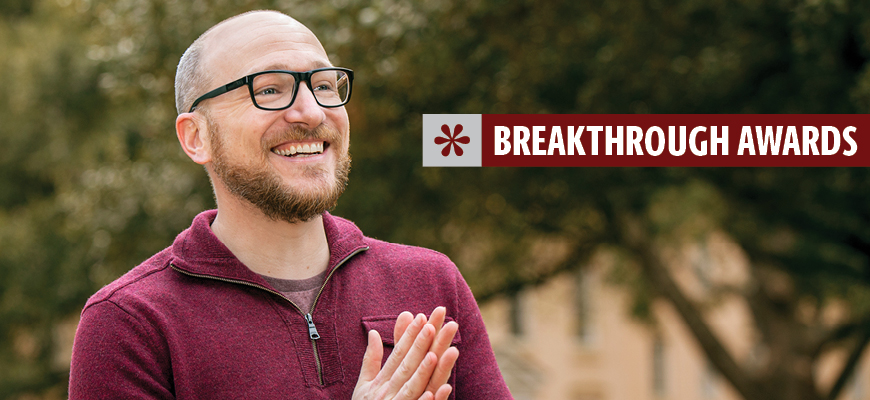
Breakthrough Star: Aaron Vannucci
Researcher aims to find cleaner fuels and cleaner ways to make products we use every day
Posted on: June 22, 2021; Updated on: June 22, 2021
By Page Ivey, [email protected], 803-777-3085
Aaron Vannucci discovered his love of chemistry in high school, and it has led to a flourishing career finding cleaner ways to make chemicals and searching for sustainable sources of fuel.
An assistant professor in the University of South Carolina’s chemistry and biochemistry department since 2014, Vannucci won the 2020 Ada B. Thomas Outstanding Advisor Award and was named a 2021 Breakthrough Star.
His work with renewable fuels research began when he was a graduate student at the University of Arizona, where he joined a research group that was just getting into the area and had a grant from the National Science Foundation.
Now he works on finding ways to turn biomass into fuel.
“Obviously, we have already put biofuels into gasoline,” Vannucci says of the process that adds ethanol, made from corn, to gasoline. “But if we can make gasoline directly from biomass, we already have all the infrastructure ready to go.”
And researchers are using the parts of plants that are considered waste, such as the corn cobs and husks, and tree bark that doesn’t go into papermaking.
It’s always the goal to be on the cutting edge. There’s no reason to do chemistry unless you’re trying to do something new.
Aaron Vannucci
“If it’s already something that’s being wasted then getting some energy out of it would be worthwhile,” he says. “Biomass is the most easily adapted renewable fuel. A much cleaner process than digging for coal or oil.”
His other research goes into finding cleaner ways to make products.
“The new methodologies he has developed show great promise to burgeon into new fields of research,” says his mentor Brian Benicewicz, the USC Educational Foundation Distinguished Professor and SmartState Endowed Chair in Polymer Nanocomposites.
One project Vannucci worked on with Benicewicz is on a flame retardant polymer that is used by companies every day, but that can’t be completely made in the U.S. or Europe because the process of making the components is too toxic. China is the only producer of the building blocks.
Benicewicz wrote the problem on a whiteboard in Vannucci’s office and Vannucci stared at a few days before coming up with a way to clean up the manufacturing process.
“There is a company in South Carolina that would love to find a new way to make this,” Vannucci says. “We haven’t made it efficient enough for it to be something that they would be able to make money off of, but we have made it much cleaner.”
And that’s a new twist for the chemist.
“There’s two aspects to this research: the academic standpoint of developing a new clean technique and learning from it, but since we are collaborating with a company, there’s also the money aspect of it that I’m not used to thinking about.”
The other side of Vannucci’s professional life is teaching and hoping to inspire his intro to chemistry students the way his high school teacher inspired him.
“I like the idea of being able to teach freshman chemistry,” he says. “I became a chemist because of my high school teacher and so freshman level is the only level I can reach people who haven’t yet made that decision that maybe they love chemistry.”
Vannucci also works with high school students in his lab during summers as well as helping local high school teachers develop new instructional tools for their classrooms.
In the end, he says, his work is all about discovery and sharing that knowledge.
“It’s always the goal to be on the cutting edge,” says Vannucci. “There’s no reason to do chemistry unless you’re trying to do something new.”
Share this Story! Let friends in your social network know what you are reading about